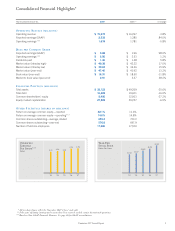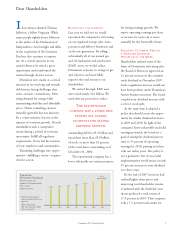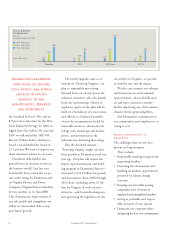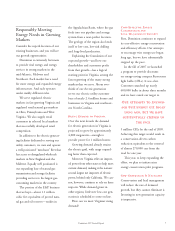Dominion Power 2007 Annual Report Download - page 13
Download and view the complete annual report
Please find page 13 of the 2007 Dominion Power annual report below. You can navigate through the pages in the report by either clicking on the pages listed below, or by using the keyword search tool below to find specific information within the annual report.
Dominion 2007 Annual Report 11
of the expected benefits of competi-
tion would not materialize. In short,
lawmakers reregulated the state’s
electric utilities, employing a
modified cost-of-service model to
set base electricity rates.
Deregulation provided an environ-
ment in which it was too risky to
build significant baseload generation.
The new law, on the other hand,
establishes a constructive framework
that provides investors the opportu-
nity to earn competitive returns on
equity. The new system allows your
company to apply to recover these
costs as they are incurred—a critical
consideration for investors—and
helps protect customers from rate
spikes.
The new rules establish environ-
mental-based incentives for con-
structing nuclear, advanced-technolo-
gy coal and natural gas facilities, and
for meeting or exceeding renewable
generation goals. They also reward
efficient operations that reduce costs
and emissions, enable cost-effective
power production and provide
excellent customer service.
REGULATORY HEARINGS TO
DETERMINE AUTHORIZED RETURNS
IN LINE WITH PEERS
As part of reregulation, Virginia
Power in 2009 will file for a review of
its base rates for the first time in a
decade. As in the past, the Virginia
State Corporation Commission will
set future rates that balance share-
holder and consumer interests. The
commission ultimately will make rul-
ings that will authorize the company
to earn rates of return no lower than
an average of those of a group
of our peer utilities in the Southeast.
Turning to the Midwest, our
Dominion East Ohio natural gas
utility serves more than 1.2 million
homes and businesses. Last year
we asked the Public Utilities
Commission of Ohio for an increase
in base rates of $73 million to recover
increased costs. This request—the
first proposed increase since 1994—
would support a 12 percent return
on equity.
WELL POSITIONED IN FAVORABLE
NORTHEAST, MIDWEST MARKETS
Our merchant fleet operates in the
Northeast and Midwest. It comprises
about 35 percent of our total electric
generation. These facilities occupy
excellent geographic locations near
high-demand centers with transmis-
sion infrastructure in place. We
began acquiring such facilities nearly
a decade ago. Since then wholesale
power prices have risen substantially.
These businesses manage their
price risks by entering into power
sales with creditworthy buyers.
We also maintain available power for
sale into spot wholesale markets as
opportunities arise.
With little new generation con-
struction anticipated in New England,
our fleet there will become all the
more valuable and all the more
necessary to serve the region’s energy
needs.
While helping to meet the energy
needs of the region, we must comply
with stringent emissions-reduction
standards adopted there, strive to
operate these units safely and efficient-
ly and seek to increase their capacity.
Unlike in New England, much
of our electric output in the Midwest
is being sold to utilities under below-
market price contracts scheduled
to expire by 2013. To begin realizing
some of this trapped value for
shareholders, last year we paid about
$230 million to buy out a contract
for our 515-megawatt State Line
Power Station in Hammond, Ind.,
near Chicago.
WITH LITTLE NEW
GENERATION CONSTRUCTION
ANTICIPATED IN NEW
ENGLAND, OUR FLEET THERE
WILL BECOME ALL THE MORE
VALUABLE AND ALL THE MORE
NECESSARY TO SERVE
THE REGION’S ENERGY NEEDS.
























